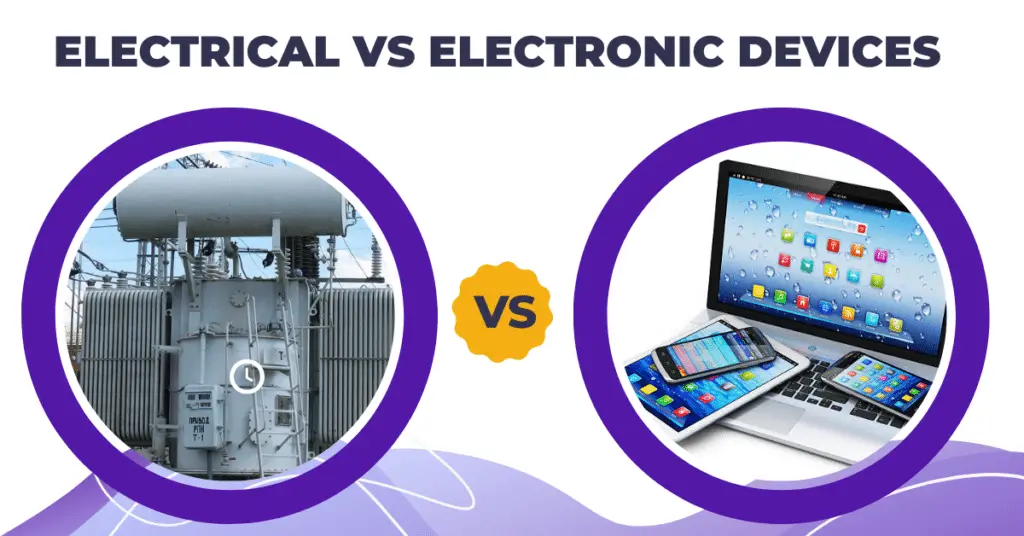This article describes the important differences between electrical devices and electronic devices. Let us first know a bit about electrical and electronic devices.
Though both electrical and electronic devices are similar to each other in the aspect that they both draw electric current to function, they are different from each other in many aspects which are explained in the below sections of this article.

What is an Electrical Device?
A device that converts electrical energy (electric current) into other forms of energy like light, heat, motion, etc. is known as an electrical device. Electrical devices are generally made of metallic conductors such as copper, aluminum, etc.

Another important point about electrical devices is that they require more electrical power at high voltage drawing high current. Therefore, electrical devices have more safety issues associated because they might cause a high-voltage electric shock. However, electrical devices are generally seen in large sizes, strong mechanical construction, and many other physical features that differentiate them from electronic devices. On the electrical side, electrical devices are less sensitive to electrical supply unbalances, so they can withstand with supply voltage surges.
Common examples of electrical devices include fans, motors, electric bulbs, fluorescent lights, electric heaters, electric iron, etc.
What is an Electronic Device?
A device whose operation is dependent and controlled by the movement of electrons and holes, and performs a specific task is known as an electronic device. The term electronics represents the behavior of electrons under the influence of an electric field. Hence, the operation of electronic devices depends upon the behavior of electrons when they are put under the effect of an electric field.

All electronic devices are made up of two types of electronic elements namely, active elements like batteries, cells, etc., and passive elements like resistors, capacitors, inductors, etc. Most electronic devices are built by using integrated circuits (ICs). Where an IC is a microelectronic circuit made up of semiconductor materials like silicon and germanium. For this reason, modern electronic devices are said to be semiconductor devices.
Examples of electronic devices are computers, smartphones, LED lamps, and digital watches. All these are electronic devices because their base components are electronics like transistors, diodes, MOSFETs, SCRs, UGTs, ICs, etc.
Now, let us discuss the key differences between electrical and electronic devices.
Difference between Electrical Devices and Electronic Devices
The key differences between electrical and electronic devices are listed in the following table:
| Key | Electrical Device | Electronic Device |
| Basic Description | An electrical device is one which transforms electrical energy into some other form of energy like motion, heat, light, etc. | An electronic device is one that controls the movement of electrons to perform a specific task. |
| Main function | An electrical device performs the conversion of electrical energy into some other form of energy. | The electronic device mainly performs the function of controlling the flow of electrical energy in a circuit. |
| Manufacturing materials | The operating parts of electrical devices like windings, etc. are made up of metals or conductors like copper, aluminum, etc. | Electronic devices are made up of semiconductor materials like silicon, germanium, etc. |
| Working voltage | Electrical devices require relatively high voltage such as 220 V, 440 V, or higher to work. | Electronic devices require low voltage such as 3 V, 5 V, 12 V, etc. to operate. |
| Current requirement | Most electrical devices require alternating current (AC) to operate. | Electronic devices always work on direct current (DC). |
| Operation speed | The operating speed of electrical devices is fast. They respond instantly on switching on the supply. | Electronic devices have comparatively slow operating speeds because they require the conversion of AC into DC and many other operations to start working. |
| Power consumption | Electrical devices consume more power. | Electronic devices require low power. |
| Safety | Electrical devices are comparatively less safe as they work on high voltages and currents. | Electronic devices are highly safe as they operate on electric voltage which can not cause hazards to a human being. |
| Data processing and conversion | Electrical devices cannot be used for data processing and conversion. | Electronic devices have the ability to process and convert data. |
| Physical size | Electrical devices are large in size. Thus, they require a large space for installation. | Electronic devices have a compact size. They require less space. |
| Examples | Fans, heaters, iron, transformer, motor, etc. are examples of electrical devices. | Transistors, diodes, computers, CPUs & processors, smartphones, etc. are examples of electronic devices. |
Conclusion
In conclusion, from the above discussion, it is clear that electrical and electronic devices are interrelated, but they are different in terms of operation, size uses, etc.
The one major difference between electrical and electronic devices which we can state from the above comparison is that the electrical device is used for energy conversion, i.e. for conversion of electrical energy into other forms, whereas the electronic device is used for controlling the flow of electric power in a circuit.
This is all about the key differences between the electrical and electronic device